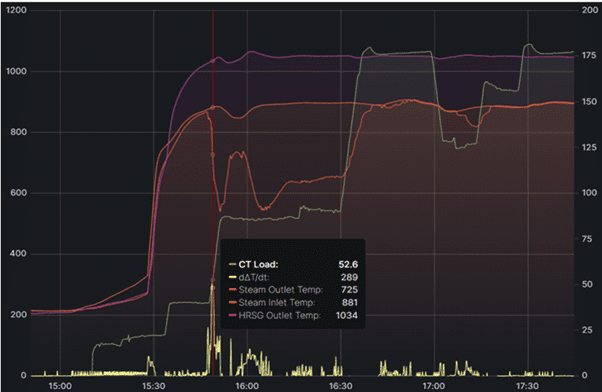Combining the Digital and the Personal in CCPP Maintenance
In the era of cloud computing, the immense potential of planned predictive maintenance (PPM) cannot be denied. Access to a broad range of application programming interfaces could revolutionise critical component servicing, if not transform it entirely. Yet, while the possibility of entirely automating this process is clearly appealing, the use of machine learning and analytics does not necessarily guarantee actionable insights. Despite the clearly huge opportunities for added value presented by digitisation, effective implementation of PPM in today’s combined cycle power plants (CCPPs) will require more than just access to technology.
Indeed, the effectiveness of PPM is determined by various factors. For example, though cloud computing allows for more cost-effective asset monitoring and eliminates the need for substantial investment in new hardware, it poses its own concerns. Namely, democratising the maintenance process through cloud-based solutions runs the risk of creating a disconnect between digital insights and real-world scenarios. What is on screen may not translate to what is happening in the plant, meaning engineering consultancy will still be needed to accurately diagnose plant issues.
Similarly, predictive maintenance predominantly relies on actual operating data rather than asset runtime alone. Though the technology may record an abundance of data, more scrutiny may be placed on the tools used for collection and not the underlying trends they should uncover. But, to an extent, this is expected. The sheer volume of data points that can be tracked, including—but not limited to—temperature, pressure, vibration, and acoustics, can lead to a push to add even more sensors and gather more information despite the wealth of relevant metrics already available. The challenge, therefore, lies not in gathering more information but in accessing and interpreting this data effectively (Figure 1).

Identifying Cracks
It is this logic that underpins IMI Insyt, the digital engineering service from IMI Critical Engineering. By focusing on leveraging historical data from CCPPs and comparing it against system-wide, physics-based analysis, tools such as IMI Insyt can identify potential issues threatening structural integrity, including cracks. This pivotal part of preventative maintenance can therefore be carried out more effectively, allowing maintenance teams to take pre-emptive action over potential cracks and reduce the risk of unplanned downtime.
This is integral, especially given the significant risks thermal stresses and the ensuing cracks in pressure boundaries can pose, particularly in areas where water injection regulates temperature. Components affected by this phenomenon, including steam turbine bypass systems and interstage attemperators, are often overshadowed by larger assets but play a crucial role in plant operations nonetheless. If neglected, these impaired parts can have a catastrophic impact on critical assets, which is why early detection and remedial work is so important.
The increased intermittency of renewables also poses a problem to plant managers. The more sporadic nature of greener energy sources necessitates CCPPs to cycle power up and down more frequently, placing systems originally designed for consistent 24-hour operation under greater operational stress.
Yet, renewables are not the only emerging contributor to system fatigue. Valve design, casting quality, and material properties have all been cited as factors exacerbating wear and tear by plant teams during conversations with the IMI Insyt team. This further underlines why reliance on software alone can be impractical, as it may lead to plant teams searching for answers in the wrong places. Instead, a comprehensive approach that integrates modelling with physical inspections will lead to the best outcomes.
Maintenance Fundamentals
Getting a full view of the problem of cracking is crucial to pre-empting serious damage to key plant components. Though most CCPP designs are unique with an array of differing components, certain unchanging fundamentals remain that govern best maintenance practice.
For instance, by analysing site performance data in key areas, such as hardware, control logic, and installation, and how they affect each other, the risk of potential failure can be negated regardless of other influencing factors. For example, though a plant’s attemperator spray valves may be correctly sized for the application, the system’s control logic could be initiating excessive spray when not needed, resulting in massive quench events and, eventually, operational failure.
Automation, where feasible, is also recommended to anticipate changing conditions accurately. Many CCPPs still have some degree of manual intervention in the control logic to quickly start up older plants designed for baseload operation, but this can lead to potential issues. Namely, this way of working may result in diminished control and impair maintenance teams’ ability to dynamically react to changing circumstances. By automating in applicable areas, these possible problems can be resolved.
Implementing this approach in real-world scenarios via the IMI Insyt framework has yielded promising results in identifying the root causes of cracking. Through analysing operational data, the IMI Insyt team has been able to identify potential concerns and recommend remedial actions to guard against future unplanned downtime. This includes replacing compromised components, modifying control logic, and upgrading valves for improved performance.
In conclusion, digital tools alone may not suffice when it comes to preventative maintenance and addressing complex engineering challenges posed by the modern power plant. An increasing reliance on more intermittent renewable power sources is likely to result in more irregular cycling at CCPPs, resulting in key components coming under further stress at even the most robust facilities. The use of historical data and in-person engineering consultancy could therefore be critical in identifying trends and signatures that may lead to failures, allowing plant managers to manage potential risks and avoid costly downtime more effectively.
—Jackie Hu is CEO of Automation at IMI. IMI Critical Engineering has long been recognised as a world-leader in the provision of flow control solutions. Its family of specialist companies design, manufacture, and service bespoke valves and actuators that precisely control the flow of steam, gas, and liquids under extremes of pressure and temperature, as well as intensely abrasive or corrosive operating conditions.